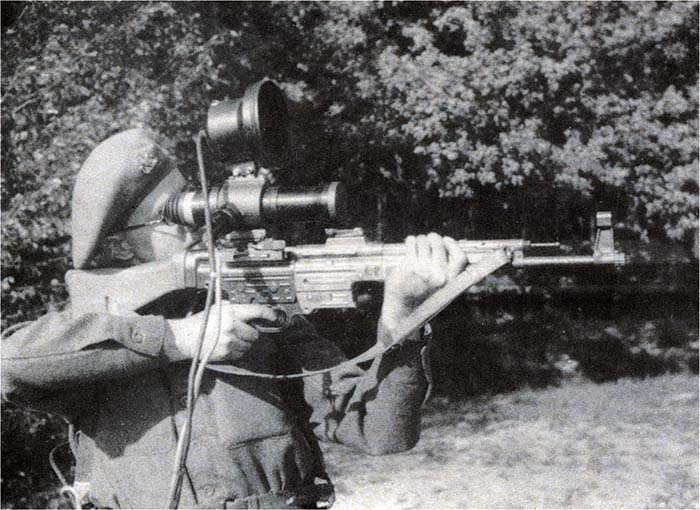Billy Mitchell’s Winchester Model 94. (Photo Jaclyn Nash, Courtesy of the Smithsonian’s National Museum of American History)
By George E. Kontis, PE
Whenever I go through any collection of firearms, I always feel lucky when I find a gun with someone’s name on it. A scrawled name or message on a gun gives us clues as to who owned it and where it was used. A lot more history dots could be connected if there were just a few more guns with names and other information on them.
Take the example of Billy Mitchell’s Winchester Model 94. It’s easy to identify as his name and date are carved into the stock. The date tells us that his rifle wasn’t too old as it had only been introduced six years earlier. In 1901, Billy wasn’t very old either. At age 22, he was stationed in Alaska, serving in the Army Signal Corps following a tour of duty during the Philippine insurrection. Since the name and date are rather crudely carved, and upside down as well, it’s pretty certain Billy didn’t do this to enhance the appearance of his rifle. There is a far more interesting story.
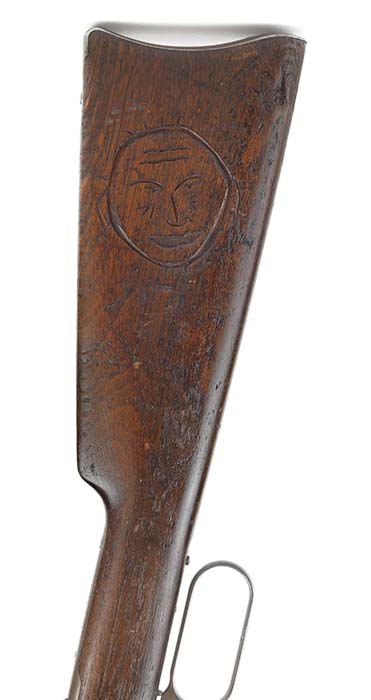
Carved “Wanted Poster” on Billy Mitchell’s Winchester Model 94. (Photo Jaclyn Nash, Courtesy of the Smithsonian’s National Museum of American History) 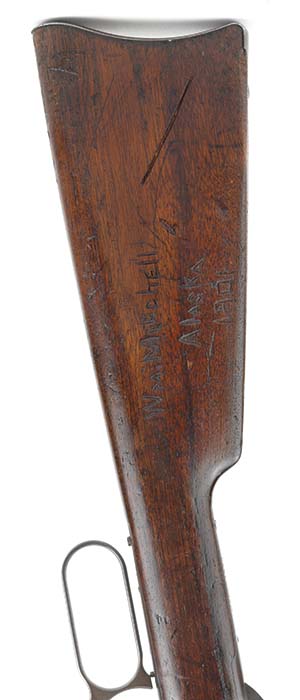
Billy Mitchell’s Winchester Model 94. (Photo Jaclyn Nash, Courtesy of the Smithsonian’s National Museum of American History)
Anticipating the thrill of a big game hunt, Billy found an Eskimo who agreed to go as his guide. Considering modern communication methods were absent in those years, it was a huge leap of faith to travel far out into the Alaskan wilderness and accept a guide’s famous last words: “You hunt here. Don’t worry; I’ll be back for you later.” But, Billy had faith that the guide would not be too far away, and would return as promised. After a couple of days had passed and the guide did not reappear, Billy began to lose hope. Not only was he sure he would not live to see his friends and family again, he was certain there would be little left of his remains. Then it occurred to him that at least his rifle might survive. If he took action, it might serve as a means to help identify whatever was left of him.
Besides his name and the date, on the opposite side of the stock he carved a picture. It might be a stylized sun, as some curators at the Smithsonian Institute believe. Others, like me, think it’s a picture of the guy that left him there – a wood-carved wanted poster. Fortunately for all of us, the guide did return because Billy Mitchell went on to play an important role in American military aviation, and today is recognized as the father of the United States Air Force. He’s the only person in history to have an American military aircraft with his name on it – the Mitchell B25 bomber.
In the case of Billy Mitchell, the name on the gun was to identify the soldier. During the Civil War, a soldier would sometimes mark his gun so he could tell which gun was his. This was particularly true with Confederate soldiers who often supplied their own firearms. Should you survey any group of Civil War guns, you’ll likely find that more Confederate guns are personalized than Union ones. It’s also probably true that Union soldiers then, as now, had to obey regulations that prohibited defacing U.S. Government property, like their assigned rifle. Firearm collectors and resellers will tell you that unless a person is famous, having a name on a gun decreases its value. If you came across an old .68 caliber muzzle loading rifle with a cut down 18-inch barrel, you may not consider it to have much value, considering it had been extensively customized. But that same rifle, with the name of the Confederate soldier and the unit he served in becomes an item of historical significance, like the Hub Coob rifle that rests today in the Milwaukee Public Museum. There are two other names on the stock that look like they were added at a different time. After the war ended, Union soldiers burned many of the Confederate records so research becomes more difficult but not impossible. At least with the names and date, there is a place to start.
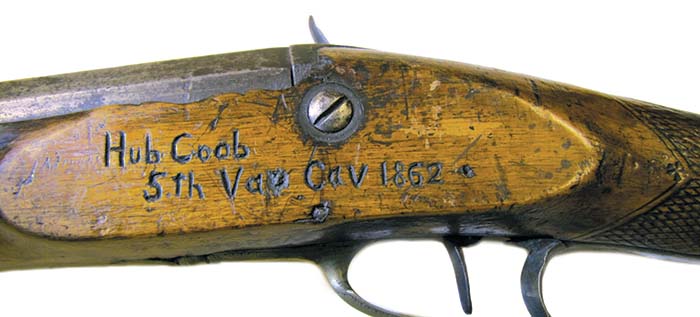
Unfortunately, many of the Confederate firearms with names don’t give the complete name which makes the historical identification challenge difficult. The Milwaukee Public Museum turned up a nice Confederate rifle, a .72 caliber Austrian percussion carbine that was nicely fitted with sling swivels, cavalry bandolier, rod and ring. The stock is incised with an encircled cross and name or initials JEHCB. Literacy wasn’t then what it is today, so the Museum calculates it was his best attempt at JACOB, which was a very common name in those days.
If you’re important enough, somebody just might give you a gun with your name on it, but don’t be surprised if there are strings attached. Henk Visser headed up a Dutch firearms manufacturing firm, NWM, and was always on the lookout for new business opportunities. Henk saw merit in the Stoner 63 machine gun and obtained a license to manufacture it outside the U.S. intending worldwide sales. He was hot on the trail of a $35 million dollar contract with the Army of the Philippines, and as a marketing ploy, decided to present one to the Philippine president, Ferdinand Marcos. Henk’s personal touch was to have it nicely engraved with
Marcos’ name.

Henk almost had it right. President Marcos did have a particular affinity for collecting serialized things with famous people’s names on them. The names he preferred were names like Lincoln, Jefferson, Grant, and Franklin, and those he liked unmarked and preferably in small denominations. Honest and honorable, Henk was only prepared to go as far as the engraved machine gun so he lost the business. The gun never did get to Marcos and the specially marked Stoner 63 has become part of the collection at the Institute of Military Technology in Titusville, FL.
Today there are a lot of good reasons why someone might want their name on a firearm. It might be to memorialize service with a military or law enforcement unit, or possibly to commemorate an award or other recognition. There are plenty of places where you can get the metal on your firearm professionally engraved and there are new laser engraving machines that do the job at a reasonable cost. For the AR series, I personally like the option of having an engraved ejection port cover. These fit on any AR rifle and can be easily removed if the rifle is sold or if the owner prefers it on a different firearm.
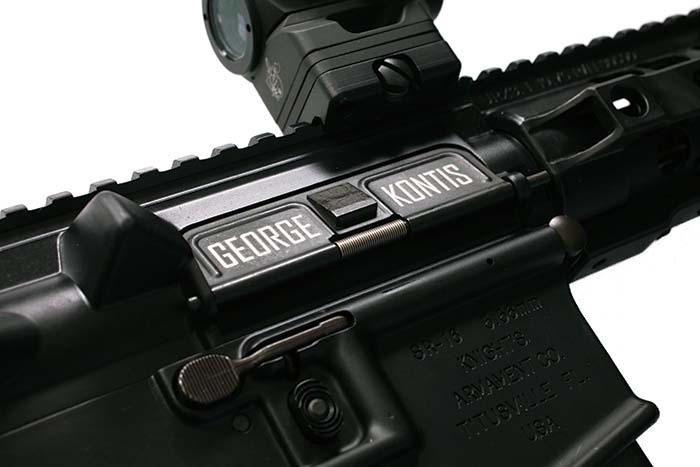
My engraved ejection port cover was purchased from Leo Armory where I was able to communicate my design and pay for it through Leo’s easy-to-use web site. Within a day I received a proof back that offered a couple of options for lettering fonts and proposed layouts. I made one design change that added a day and one more proof to approve, but the following day I was notified by email that my custom ejection port cover was on its way to me.
Whether used or owned by famous people, ordinary folk, or real knuckleheads, I like to see guns with names on them. While any kind of message can be engraved, historians like me would appreciate your name, spelled correctly, if you don’t mind.
| This article first appeared in Small Arms Review V19N5 (June 2015) |





